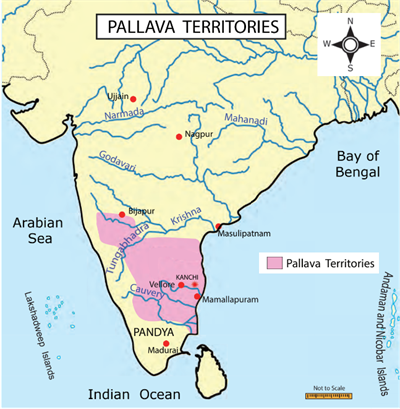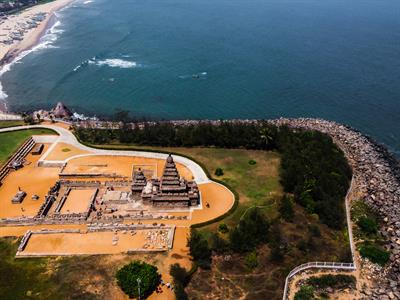PDF chapter test TRY NOW
The Pallava kings of Kanchipuram had taken over the rule of the far south by the early seventh century, coinciding with the Harsha's reign in the north. The Chola and Pandya dynasties were under Pallava rule.
In their different river valley districts, the latter developed into dominating dynasties. The Rashtrakutas afterwards drove the Chalukyas of Badami (Vatapi) out of much of the central and eastern Deccan.
The establishment of regional centres of authority in India during the mediaeval era was notable. During this time, India was not dominated by a single imperial force like the Mauryas or the Guptas.
The Pallavas
The Pallava kings of Kanchipuram had taken control of the far south by the early seventh century, synchronising with the Harsha's reign in the north. The Cholas' and Pandya's kingdoms were incorporated into Pallava's rule.
In their different river valley districts, the latter developed as governing dynasties. The Chalukyas of Badami (Vatapi) ruled most of the central and eastern Deccan until being pushed out by the Rashtrakutas.

Pallava Territories in 7th Century
The rise of regional power centres marked the mediaeval period in India. During this time, no single imperial force wielded sovereignty over the majority of India, such as the Mauryas or the Guptas.
Pallavas:
Around the fourth century AD, the Pallavas emerged as a strong force in the South, and by the seventh century AD, they had reached the pinnacle of their supremacy. They were able to dominate for almost \(500\) years. They influenced a considerable part of Southeast Asia's culture by building great cities, learning centres, temples, and statues.

Shore Temple of Mahabalipuram
The extent of the Pallava dynasty
The Pallava capital was Kanchipuram, and their holdings stretched from northern Andhra Pradesh to the River Kaveri in the south during the height of their dominance. The Cholas were reduced to a minor power by the Pallavas' authority in the seventh century.
The Pallava monarch Narasimhavarman invaded Vatapi (Badami) after defeating the Chalukyas.
The Pandyas, Chalukyas, and Pallavas all joined forces to defeat the Kalabhra insurrection. The Kalabhras protested the Brahmanic monarchs of the three dynasties' many land concessions (Brahamadeya) to Brahmanas.
Rulers of the Pallava Empire
1. Sivaskanda Varman
The most powerful of the early rulers. Performed Ashwamedha and other Vedic sacrifices during the start of the fourth century AD. Simhavarman/Simhavishnu (Reign: \(575\) AD – \(600\) AD)
He was a Buddhist who incorporated Sri Lanka into his empire and defeated the current Tamil King.
From this emperor onwards, Pallava's history takes on a distinct personality.
2. Mahendravarman (\(600\) AD – \(630\) AD)
He succeeded his father, Simhavishnu, and was a poet who wrote the Vichitrachita and Mahavilasa Prahasana. He was the first to pioneer rock-cut temple architecture. He was a massive supporter of the arts and architecture.
He is credited with establishing a new Dravidian architecture known as the 'Mahendra style.'
Converted from Jainism to Saivism. Appar, a Saivite saint, turned him to Saivism (Tirunavukkarasar).
Pulakesin II of the Chalukya dynasty was a constant source of competition and wars. In one of the conflicts, Pulakesin appears to have defeated Mahendravarman and taken over a significant portion of his land (Vengi) in the north. In a battle with the Chalukyas, Mahendravarman was killed. He was a capable and capable dictator.
3. Narasimhavarman I (\(630\) AD – \(668\) AD)
Considered the greatest of the Pallavas; son and successor of Mahendravarman. Mamallan is another name for Narasimhavarman.
In \(642\) AD, he defeated and murdered Pulakesin II. He claimed the title of "Vatapikonda" and took control of Vatapi, the Chalukya capital. He also defeated the Cholas, Cheras, and Pandyas.
He dispatched a naval expedition to Sri Lanka, where he restored Sinhalese Prince Manivarma. He founded the city of Mamallapuram, now known as Mahabalipuram, which bears his name.
During Hiuen Tsang's rule in around \(640\) AD, he visited the Pallava realm and described the people who lived there as cheerful. He also claims that agricultural products were plentiful.
During his reign, great Nayannar saints such as Appar, Tirugnanasambandar, and Siruthondar lived. His son Mahendravarman II, who reigned from \(668\) to \(670\) AD, succeeded him.
Later rulers:
After Mahendravarman II, his son Parameswaravarman became king, and the Chalukyas invaded Kanchipuram during his reign.
There were a few other monarchs, including Nripatunga, who defeated a Pandya king.
Aparajitavarman, the Pallava dynasty's last emperor, was killed in battle with the Cholas.
Reference:
Pallava Territories: Tamil Nadu textbook 6th Std Social Science
